Module-3
Vector differential calculus
Vector function-
Suppose  be a function of a scalar variable t, then-
be a function of a scalar variable t, then-

Here vector  varies corresponding to the variation of a scalar variable t that its length and direction be known as value of t is given.
varies corresponding to the variation of a scalar variable t that its length and direction be known as value of t is given.
Any vector  can be expressed as-
can be expressed as-

Here  ,
,  ,
,  are the scalar functions of t.
are the scalar functions of t.
Differentiation of a vector-

We can denote it as- 
Similarly  is the second order derivative of
is the second order derivative of 
Note-  gives the velocity and
gives the velocity and  gives acceleration.
gives acceleration.
Note-
1. Velocity = 
2. Acceleration = 
The derivative of the velocity vector V(t) is called acceleration A(t), and it is given as-

Rules for differentiation-
1. 
2. 
3. 
4. 
5. 
Example-1: A particle moves along the curve  , here ‘t’ is the time. Find its velocity and acceleration at t = 2.
, here ‘t’ is the time. Find its velocity and acceleration at t = 2.
Sol. Here we have-

Then, velocity

Velocity at t = 2,
= 
Acceleration = 
Acceleration at t = 2,

Example-2: If  and
and  then find-
then find-
1. 
2. 
Sol 1. We know that-




2.



Example-3: A particle is moving along the curve x = 4 cos t, y = 4 sin t, z = 6t. then find the velocity and acceleration at time t = 0 and t = π/2.
And find the magnitudes of the velocity and acceleration at time t.
Sol. suppose 
Now,
At t = 0 |
|
At t = π/2 |
|
At t = 0 | |v|= |
At t = π/2 | |v|= |
Again acceleration-

Now-
At t = 0 |
|
At t = π/2 |
|
At t = 0 | |a|= |
At t = π/2 | |a|= |
Scalar point function-
If for each point P of a region R, there corresponds a scalar denoted by f(P), in that case f is called scalar point function of the region R.
Note-
Scalar field- this is a region in space such that for every point P in this region, the scalar function ‘f’ associates a scalar f(P).
Vector point function-
If for each point P of a region R, then there corresponds a vector  then
then  is called a vector point function for the region R.
is called a vector point function for the region R.
Vector field-
Vector filed is a reason in space such that with every point P in the region, the vector function  associates a vector
associates a vector  (P).
(P).
Note-
Del operator-
The del operated is defined as-

Example: show that  where
where 
Sol. here it is given-


= 
Therefore-

Note-
Hence proved
Key takeaways-


Here  ,
,  ,
,  are the scalar functions of t.
are the scalar functions of t.
1. Velocity = 
2. Acceleration = 
3. Scalar field- this is a region in space such that for every point P in this region, the scalar function ‘f’ associates a scalar f(P).
4. Vector field-
Vector filed is a reason in space such that with every point P in the region, the vector function  associates a vector
associates a vector  (P).
(P).

Tangential and normal accelerations-
It is very important to understand that the magnitude of acceleration is not always the rate of change of |V|.
Suppose  be the vector-valued function which denotes the position of any object as a function of time.
be the vector-valued function which denotes the position of any object as a function of time.
Then

Then the tangential and normal component of acceleration are given as below-


Example: A object move in the path  where t is the time in seconds and distance is measured in feets.
where t is the time in seconds and distance is measured in feets.
Then find  and
and  as functions of t.
as functions of t.
Sol.
We know that-

And

Now we will use-



And now-



Key takeaways-



The vector differential operator is written as-

Gradient
Suppose f(x, y, z) be the scalar function and it is continuously differentiable then the vector-

Is called gradient of f and we can write is as grad f.
So that-

Here  is a vector which has three components
is a vector which has three components 
Properties of gradient-
Property-1: 
Proof:
First we will take left hand side
L.H.S = 
= 
= 
= 
Now taking R.H.S,
R.H.S. = 
= 
= 
Here- L.H.S. = R.H.S.
Hence proved.
Property-2: Gradient of a constant (
Proof:
Suppose 
Then 
We know that the gradient-


= 0
Property-3: Gradient of the sum and difference of two functions-
If f and g are two scalar point functions, then

Proof:
L.H.S 




Hence proved
Property-4: Gradient of the product of two functions
If f and g are two scalar point functions, then

Proof:




So that-

Hence proved.
Property-5: Gradient of the quotient of two functions-
If f and g are two scalar point functions, then-

Proof:
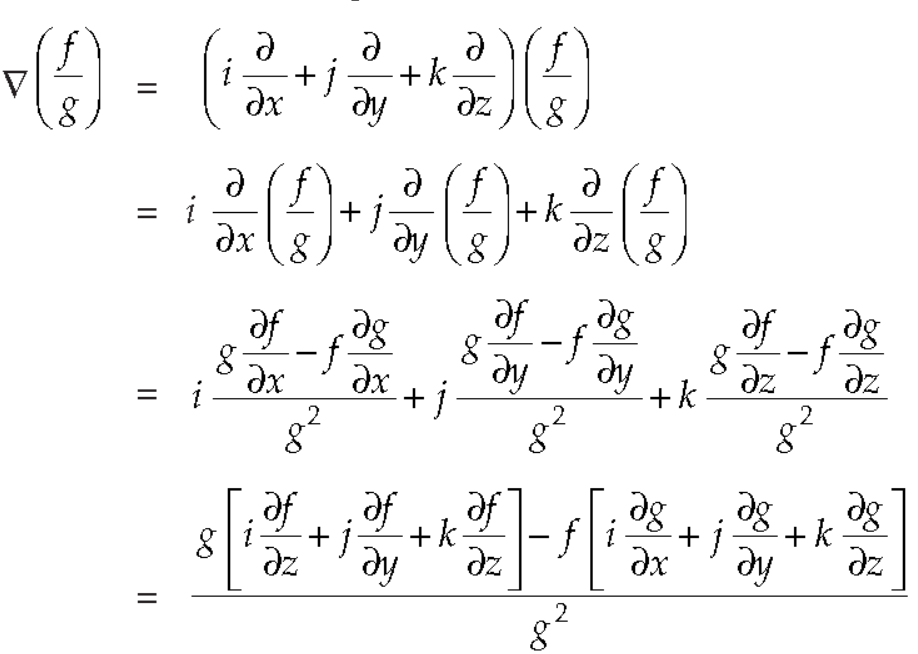
So that-

Example-1: If  , then show that
, then show that
1. 
2. 
Sol.
Suppose  and
and 

Now taking L.H.S,

Which is 
Hence proved.
2. 
So that

Example: If  then find grad f at the point (1,-2,-1).
then find grad f at the point (1,-2,-1).
Sol.



Now grad f at (1 , -2, -1) will be-


Example: If  then prove that grad u , grad v and grad w are coplanar.
then prove that grad u , grad v and grad w are coplanar.
Sol.
Here- 


Now-


Apply 


Which becomes zero.
So that we can say that grad u, grad v and grad w are coplanar vectors.
Divergence (Definition)-
Suppose  is a given continuous differentiable vector function then the divergence of this function can be defined as-
is a given continuous differentiable vector function then the divergence of this function can be defined as-

Curl (Definition)-
Curl of a vector function can be defined as-

Note- Irrotational vector-
If  then the vector is said to be irrotational.
then the vector is said to be irrotational.
Vector identities:
Identity-1: grad uv = u grad v + v grad u
Proof:
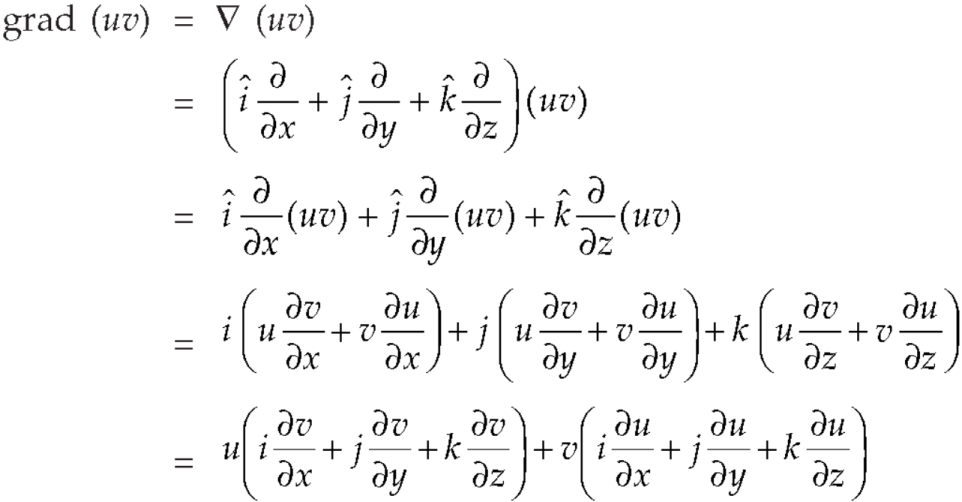
So that
graduv = u grad v + v grad u
Identity-2: 
Proof:
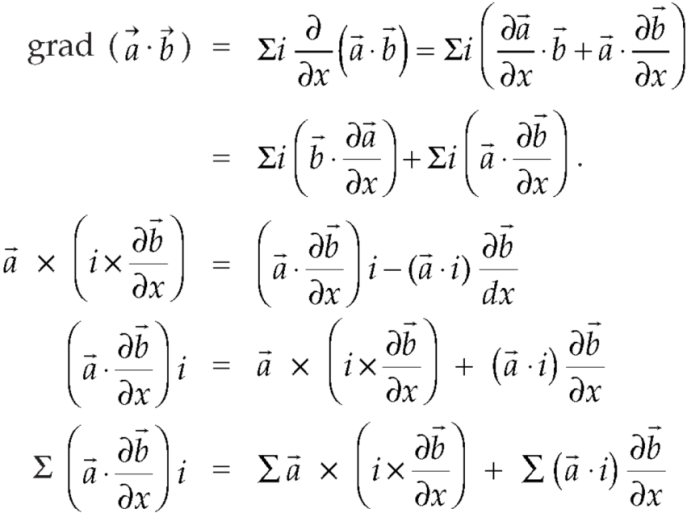

Interchanging  , we get-
, we get-

We get by using above equations-

Identity-3
Proof: 

So that-

Identity-4
Proof:
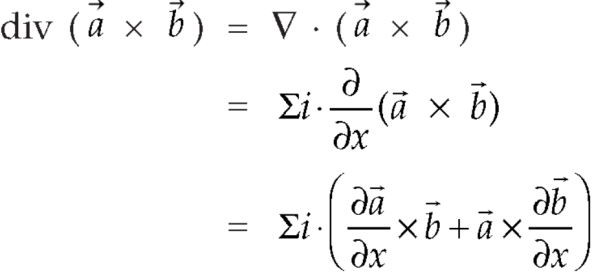
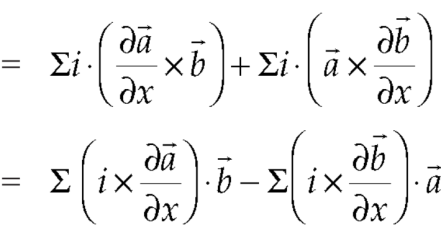

So that,

Identity-5 curl (u
Proof:
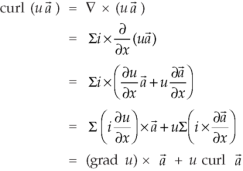
So that
curl (u
Identity-6: 
Proof:
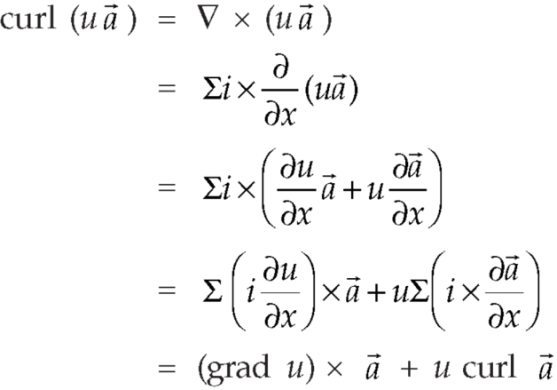
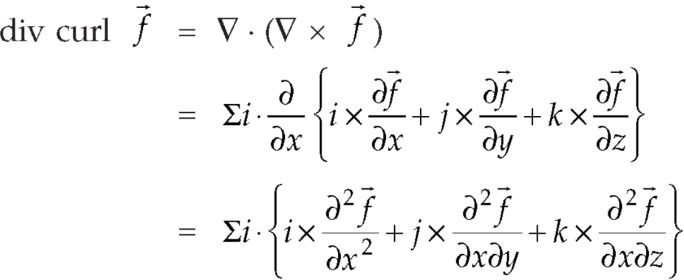
So that-

Identity-7: 
Proof:
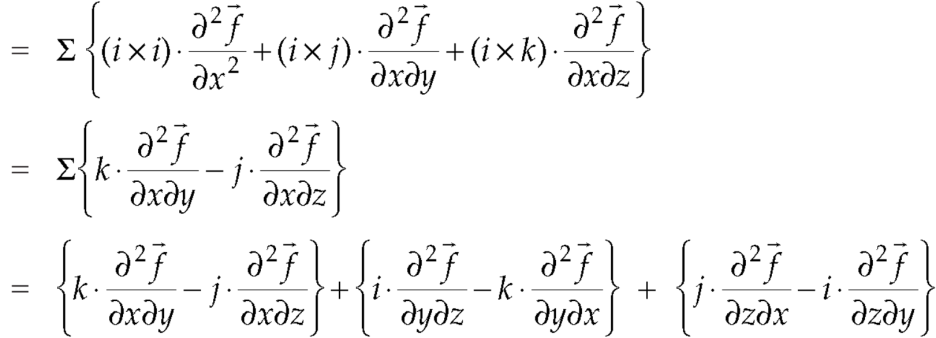
So that-

Example-1: Show that-
1. 
2.
Sol. We know that-




2. We know that-



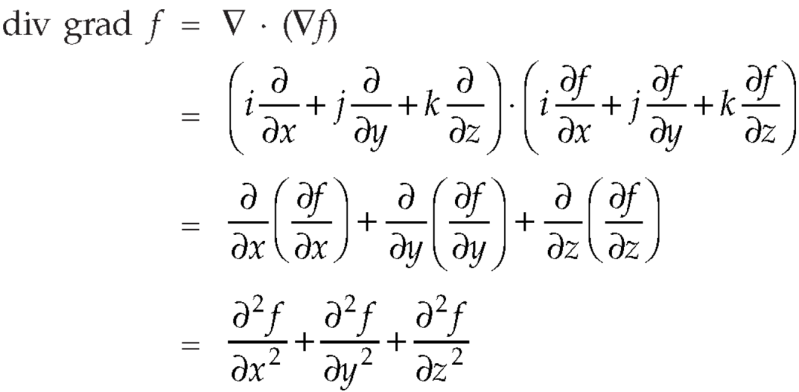
 = 0
= 0
Example-2: If  then find the divergence and curl of
then find the divergence and curl of  .
.
Sol. we know that-


Now-


Example-3: Prove that 
Note- here  is a constant vector and
is a constant vector and 
Sol. here  and
and 
So that

Now-

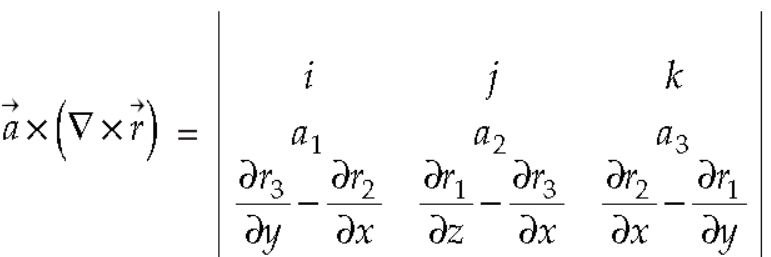

So that-

Key takeaways-




If f and g are two scalar point functions, then

5. If f and g are two scalar point functions, then

6. If f and g are two scalar point functions, then-

7. 
8. 
9. If  then the vector is said to be irrotational.
then the vector is said to be irrotational.
10. grad uv = u grad v + v grad u
11. 
12. curl (u
References









